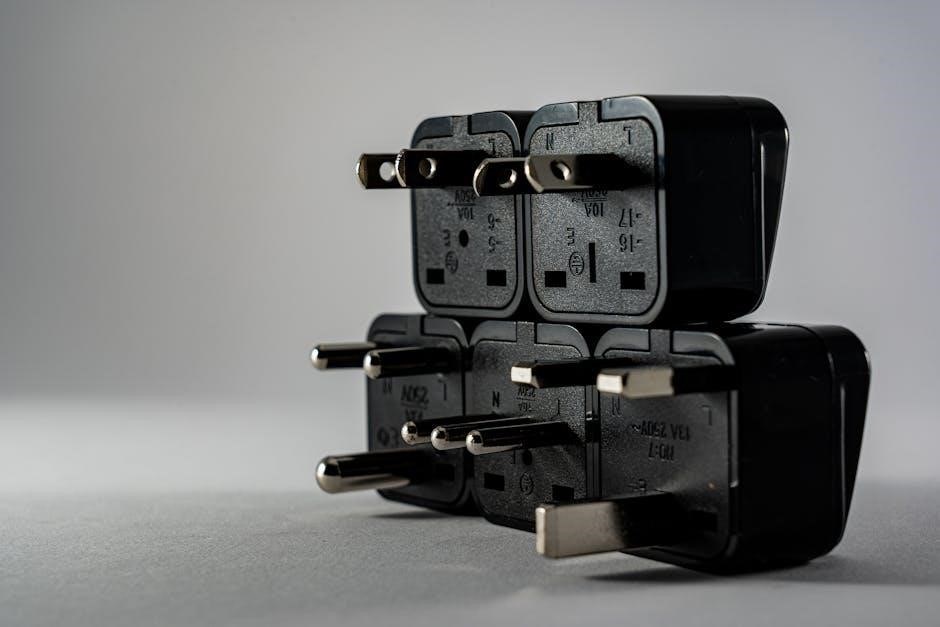This comprehensive guide provides a portable resource for understanding electrical safety protocols through multiple-choice and fill-in-the-blank questions‚ ideal for self-assessment and training environments.
Overview of the Importance of Electrical Safety
Electrical safety is a fundamental aspect of preventing accidents‚ injuries‚ and fatalities caused by electrical hazards. It ensures the protection of lives‚ property‚ and equipment from potential dangers such as electric shocks‚ fires‚ and explosions. Understanding electrical safety principles is crucial for identifying and mitigating risks in both household and workplace environments. Proper safety practices‚ including the use of insulated tools‚ voltage testers‚ and personal protective equipment (PPE)‚ are essential for safeguarding individuals and maintaining compliance with legal and industry standards. Regular training and awareness programs play a vital role in promoting a culture of safety‚ enabling everyone to recognize hazards and take appropriate measures to avoid them.
Benefits of Using Quiz Questions for Training
Using quiz questions for training is an effective way to reinforce electrical safety knowledge and ensure understanding. Quizzes engage participants actively‚ making learning interactive and memorable. They help identify knowledge gaps‚ allowing for targeted improvement. Regular testing improves retention of critical safety practices‚ such as handling damaged cords or using PPE correctly. Quizzes also provide immediate feedback‚ enabling learners to verify their answers and clarify doubts. This method fosters a culture of continuous learning and prepares individuals to apply safety protocols in real-world scenarios. By incorporating quizzes into training programs‚ organizations can enhance compliance‚ reduce risks‚ and promote a safer work environment.
Structure of the PDF Guide
The PDF guide is organized into clear sections‚ each focusing on specific aspects of electrical safety. It begins with an introduction to the importance of electrical safety‚ followed by household and workplace safety questions. The guide also covers tools‚ PPE‚ and advanced topics like arc flash and lockout/tagout procedures. Each section includes multiple-choice questions and detailed answers‚ making it easy to navigate and use for self-assessment or training. The comprehensive structure ensures that users can systematically review and master electrical safety principles‚ from basic concepts to complex scenarios. This organized approach enhances learning efficiency and ensures that all key areas are thoroughly covered.
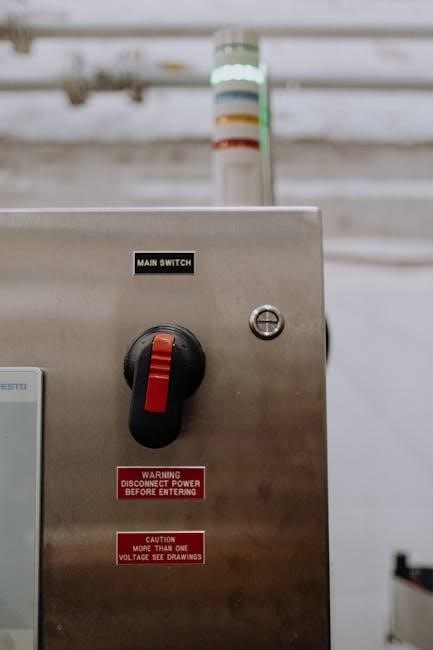
Household Electrical Safety Quiz Questions
Test your knowledge on preventing electrical fires‚ safe appliance usage‚ and emergency responses like downed power lines. Multiple-choice questions cover essential household safety practices and practical tips.
What to Do If You See a Downed Power Line
If you encounter a downed power line‚ stay at least 30 feet away‚ as the ground around it may be energized. Never touch the line or nearby objects. Immediately contact your local power company or emergency services. Do not attempt to move or repair the line yourself. Keep others away to prevent accidents. Remember‚ downed lines can cause severe electrical shock‚ even if they appear harmless. Always prioritize safety and follow proper protocols to avoid potential hazards.
Preventing Electrical Fires at Home
To prevent electrical fires‚ avoid overloading outlets and extension cords‚ as this can cause excessive heat buildup. Use surge protectors and ensure all cords are in good condition‚ free from frays or damage. Regularly inspect electrical appliances for signs of wear or malfunction. Install smoke alarms on every level of your home and test them monthly. Keep flammable materials like curtains or bedding away from heating devices or outlets. Never use electrical appliances near water‚ as this increases the risk of shock and fire. Store electrical devices and cords properly when not in use‚ and consider having your home’s electrical system inspected by a professional if you notice any issues.
Safe Usage of Electrical Appliances Indoors
Ensuring the safe usage of electrical appliances indoors is crucial to prevent accidents and fires. Always follow the manufacturer’s instructions for installation‚ operation‚ and maintenance. Avoid overloading circuits with too many devices‚ as this can lead to overheating. Use surge protectors to safeguard appliances from voltage spikes. Keep electrical appliances away from water sources‚ such as bathtubs or sinks‚ to reduce the risk of electric shock. Regularly inspect cords and plugs for damage or fraying and replace them if necessary. Never use damaged appliances‚ as they can pose serious safety hazards. Additionally‚ store appliances and cords properly when not in use to avoid tripping hazards or unintended activation. By adhering to these practices‚ you can significantly enhance electrical safety in your home.
Workplace Electrical Safety Quiz Questions
Test your knowledge on workplace electrical safety with these questions covering topics like authorized personnel‚ handling damaged cords‚ and proper dress codes for inspections.
Authorized Personnel for Electrical Equipment
Only trained and authorized employees should work on electrical equipment to ensure safety and compliance with regulations. OSHA requires that workers be properly trained and certified to handle electrical tasks. Unauthorized individuals should never attempt to operate or repair electrical systems‚ as this poses significant risks. Proper personal protective equipment (PPE) must be worn during such operations. Employers must verify that employees understand electrical safety protocols before assigning tasks. Regular updates and refreshers on electrical safety standards are essential to maintain compliance and prevent accidents. Always ensure equipment is de-energized before starting work‚ and use lockout/tagout procedures to confirm safety. Unauthorized access can lead to severe injuries or fatalities‚ making it critical to enforce these restrictions strictly.
Proper Handling of Damaged Cords
When a damaged cord is identified‚ it is crucial to stop using the appliance immediately and unplug it from the power source. Wrapping tape around the damaged area is not a safe or recommended solution. Instead‚ the cord should be properly repaired or replaced by a qualified professional. Using damaged cords can lead to electrical shocks‚ fires‚ or equipment malfunction‚ posing serious safety risks. Regular inspections of cords and cables are essential to identify wear and tear early. If damage is detected‚ label the equipment as unsafe and remove it from service until repairs are made. Proper handling ensures compliance with safety standards and prevents potential hazards in both household and workplace environments.
Dress Code for Electrical Inspections
During electrical inspections‚ proper attire is essential to ensure safety and minimize risks. Personnel should wear non-conductive‚ flame-resistant clothing and avoid loose items that could catch fire or conduct electricity. Steel-toe boots are recommended to protect against heavy equipment and tools. Hard hats and safety glasses are mandatory to prevent head and eye injuries. Insulated gloves are necessary when handling live electrical components. Long sleeves and pants should be worn to reduce skin exposure. Additionally‚ any jewelry that could conduct electricity should be removed. Proper PPE ensures compliance with safety standards and protects workers from electrical hazards during inspections.
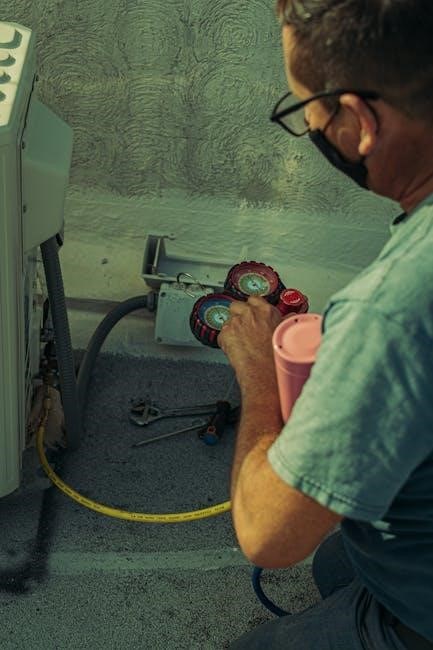
Electrical Safety Tools and Equipment Quiz
This section focuses on tools like insulated hand tools‚ voltage testers‚ and circuit breakers‚ emphasizing their roles in preventing electrical shocks and ensuring safe working conditions.
Importance of Insulated Tools
Insulated tools are essential for protecting users from electrical shocks. They feature non-conductive materials that prevent the flow of electricity‚ ensuring safety when working with live circuits. Proper use of these tools reduces the risk of accidents and injuries. Regular inspection and maintenance of insulation are crucial to maintain their effectiveness. Additionally‚ insulated tools comply with safety standards‚ making them a must-have for electrical work. Their role in preventing electrical hazards cannot be overstated‚ as they act as a barrier between the user and potentially dangerous voltages. This emphasis on safety underscores their importance in both household and professional settings.
Using Voltage Testers Safely
Voltage testers are crucial for verifying the absence of electricity in a circuit‚ ensuring safe working conditions. Always select a tester rated for the voltage being tested. Before use‚ inspect the device for damage and ensure proper insulation to prevent shocks. Never rely solely on the tester’s light; cross-check with a multimeter if available. Avoid using testers near water‚ as moisture can conduct electricity. After testing‚ treat the circuit as live unless confirmed otherwise. Regularly maintain and update testers to ensure accuracy. Proper use of voltage testers minimizes the risk of electrical accidents‚ making them indispensable for safe electrical work. Adhering to these guidelines ensures reliable and secure testing procedures.
Role of Circuit Breakers
Circuit breakers play a vital role in protecting electrical systems from overcurrent conditions‚ such as short circuits or overloads. They act as automatic switches that interrupt the power supply when excessive current flows‚ preventing damage to equipment and reducing fire risks. Unlike fuses‚ circuit breakers can be reset‚ making them reusable and more convenient for long-term use. Proper installation and maintenance of circuit breakers ensure reliable operation and safety. They are essential for safeguarding both household and industrial electrical systems. Understanding their function is crucial for maintaining electrical safety and preventing potential hazards. Regular inspections and testing of circuit breakers are recommended to ensure they operate effectively during emergencies. Their role in modern electrical systems cannot be overstated‚ as they provide a critical layer of protection for people and property. Always ensure circuit breakers are used correctly to maintain electrical safety standards.

Personal Protective Equipment (PPE) Quiz
This section assesses knowledge on PPE for electrical work‚ including types‚ testing‚ and correct usage‚ ensuring workers understand how to protect themselves from electrical hazards effectively.
Types of PPE for Electrical Work
Personal Protective Equipment (PPE) for electrical work includes insulating gloves‚ safety glasses‚ hard hats‚ and fire-resistant clothing. Insulating gloves prevent electrical shock‚ while safety glasses protect eyes from debris. Hard hats shield against falling objects‚ and fire-resistant materials reduce arc flash risks. These items are essential for safeguarding workers during electrical tasks‚ ensuring compliance with safety standards and minimizing injury risks. Regular testing and maintenance of PPE are crucial to guarantee their effectiveness in hazardous situations. Understanding the correct types of PPE and their applications is vital for all individuals working with electrical systems. This section helps quiz participants identify and explain the various PPE used in electrical environments‚ promoting a safer workplace.
Testing and Maintenance of PPE
Regular testing and maintenance of Personal Protective Equipment (PPE) are critical to ensure its effectiveness in preventing electrical injuries. Insulating gloves‚ for instance‚ must be tested every six months or according to manufacturer guidelines to verify their electrical resistance. Visual inspections should be conducted before each use to check for signs of wear‚ cracks‚ or damage. Proper storage in a dry‚ cool place away from direct sunlight is essential to maintain the integrity of PPE. Additionally‚ all protective gear should be cleaned and serviced as recommended by the manufacturer. Neglecting these steps can compromise safety and lead to equipment failure during emergencies. This section emphasizes the importance of routine maintenance to ensure PPE remains reliable and compliant with safety standards.
Correct Use of Insulating Gloves
Insulating gloves are essential for protecting workers from electrical shocks when handling live circuits. They must be worn correctly‚ ensuring they are snug but not restrictive. Before use‚ gloves should be visually inspected for any damage or wear. Testing the gloves annually‚ or as per manufacturer guidelines‚ is mandatory to ensure their insulation properties remain intact. Proper sizing is crucial to maintain dexterity and prevent accidents. Gloves should be stored in a dry‚ cool environment to preserve their effectiveness. During use‚ avoid touching conductive materials with bare hands‚ and ensure the gloves are rated for the voltage level of the task. Adhering to these practices ensures maximum protection and compliance with electrical safety standards.
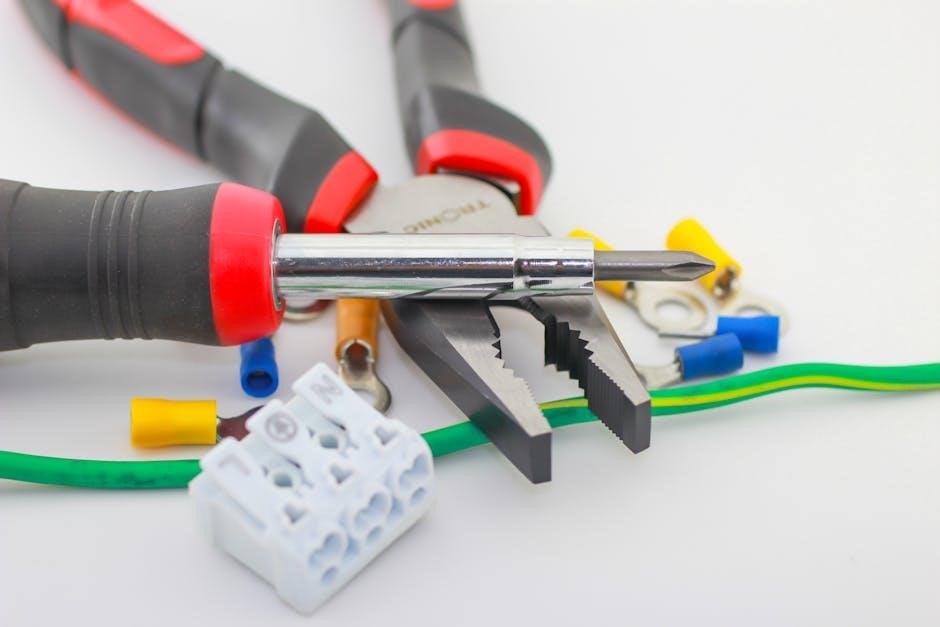
Lockout/Tagout Procedures Quiz
This section assesses knowledge on Lockout/Tagout procedures‚ including steps to ensure equipment is de-energized‚ proper verification‚ and effective communication during procedures to maintain a safe work environment.
Steps for Lockout/Tagout
Lockout/Tagout procedures ensure equipment safety during maintenance. The process begins with notifying all affected personnel. Next‚ shut down the equipment and isolate energy sources. Apply locks and tags to all energy-isolating devices‚ ensuring only authorized workers can remove them. Verify equipment is de-energized using test instruments. Finally‚ document the process and communicate with the team to confirm safety before starting work. These steps prevent unexpected startups and protect workers from electrical hazards.
Ensuring Equipment is De-energized
Verifying that equipment is de-energized is critical for electrical safety. First‚ switch off the power source and disconnect it from the main supply. Use voltage testers to confirm there is no residual voltage. Check all capacitors and inductive loads‚ as they can store energy even when powered off. Ensure all stored energy has been safely discharged or bled off. Document the process to maintain accountability. Always follow manufacturer guidelines and safety protocols to prevent any unexpected energization. This step is vital in lockout/tagout procedures to protect workers from electrical shocks or equipment startup.
Communication During Procedures
Effective communication is essential during electrical safety procedures to ensure all team members are aware of their roles and the status of the equipment. Verbal commands and hand signals should be clear and standardized to avoid misunderstandings. Before starting any work‚ a pre-job briefing should outline the steps‚ potential hazards‚ and emergency protocols. All personnel must confirm understanding and acknowledge their responsibilities. Communication should continue throughout the procedure‚ with updates on the equipment’s status and any changes in conditions. Proper documentation of the process‚ including who is involved and the outcomes‚ is also critical for accountability and future reference. Clear communication helps prevent accidents and ensures compliance with safety standards.

Electrical Safety Resources and Downloads
Access downloadable PDF guides‚ online platforms‚ and AI tools to create or customize electrical safety quizzes‚ enhancing training efficiency and knowledge retention for individuals and organizations.
Downloading Safety Quiz PDFs
Downloading electrical safety quiz PDFs is a convenient way to access comprehensive resources for training and self-assessment. Websites like Gkseries.com offer free downloadable PDFs containing multiple-choice questions and answers on electrical safety. These documents cover a wide range of topics‚ from household safety to advanced electrical procedures. Additionally‚ platforms like OnlineExamMaker provide AI-powered tools to generate custom quizzes‚ allowing users to tailor questions to specific training needs. These PDFs are portable‚ making them ideal for offline study or workplace training sessions. They often include detailed explanations‚ ensuring learners understand key concepts and protocols.Downloading these resources is a practical step toward enhancing electrical safety knowledge and compliance in both personal and professional settings.
Online Platforms for Quiz Creation
Online platforms simplify the creation of electrical safety quizzes‚ offering user-friendly tools to design and customize assessments. Websites like Kahoot and Quizlet provide interactive environments for building quizzes‚ while platforms such as Quizizz allow real-time scoring and analysis. These tools support multiple question formats‚ including multiple-choice and true/false‚ making them versatile for various training needs. Additionally‚ some platforms offer AI-generated questions‚ streamlining the quiz creation process. Many platforms are accessible via desktop or mobile‚ enabling seamless quiz distribution and participation. These resources are invaluable for trainers and educators aiming to enhance electrical safety knowledge in an engaging and efficient manner.
Using AI Tools for Custom Quizzes
AI tools revolutionize the creation of custom electrical safety quizzes by streamlining the development process. Platforms like OnlineExamMaker leverage natural language processing and machine learning to generate relevant questions tailored to specific topics. Users can input keywords or select categories‚ and the AI produces multiple-choice‚ true/false‚ or open-ended questions. Customization options allow adjustments in difficulty levels‚ question formats‚ and even the inclusion of multimedia elements. Additionally‚ AI tools offer automated grading and real-time analytics to track participant performance. These features save time and ensure quizzes are engaging and up-to-date‚ making them ideal for workplace training or educational settings focused on electrical safety.
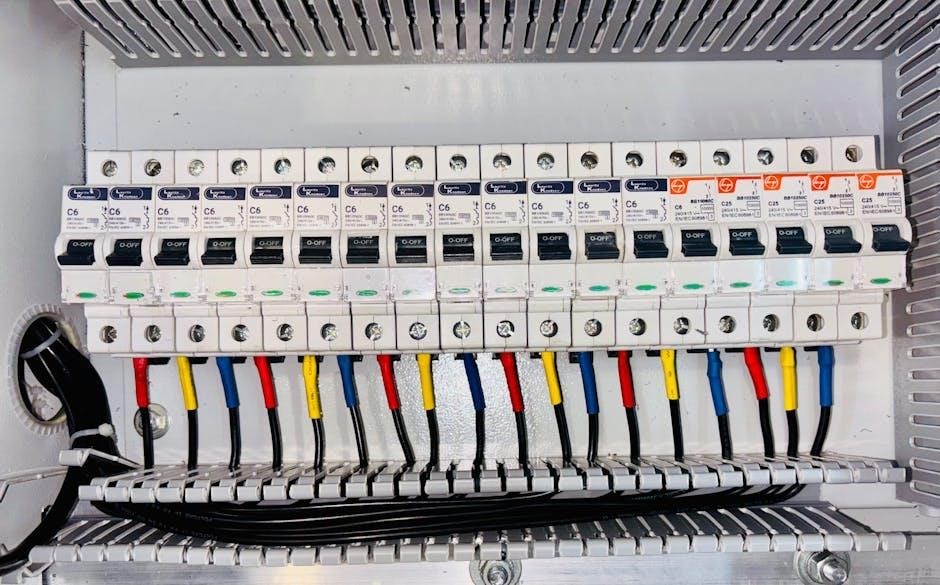
Advanced Electrical Safety Topics Quiz
Test knowledge on complex electrical safety concepts like arc flash‚ approach boundaries‚ and emergency response procedures with detailed questions and answers.
Understanding Arc Flash
An arc flash is a dangerous electrical phenomenon caused by a short circuit or equipment failure‚ resulting in an explosive release of energy. It produces intense heat‚ light‚ and force‚ posing severe risks to workers. Understanding arc flash hazards is critical for electrical safety‚ as it can cause burns‚ injuries‚ and fatalities. The flash can occur when there is improper electrical work‚ equipment malfunction‚ or insufficient maintenance. Protecting against arc flash involves using proper personal protective equipment (PPE)‚ such as arc-rated clothing and helmets. Employers must ensure compliance with safety standards like NFPA 70E to minimize risks. Regular training and hazard assessments are essential to prevent such incidents.
Approach Boundaries Explained
Approach boundaries are critical safety limits defined to protect workers from electrical hazards. These boundaries vary based on voltage levels and are established by standards like NFPA 70E. The prohibited approach boundary is the closest distance an unqualified person can safely approach live electrical equipment without risking arc flash or shock. Crossing this boundary without proper PPE can be deadly. Restricted approach boundaries require authorized personnel with appropriate training and gear. Understanding these boundaries is essential for compliance with OSHA regulations and ensuring workplace safety during electrical tasks. Proper training and equipment are vital to prevent accidents when working near energized systems.
Emergency Response Vehicles Placement
Proper placement of emergency response vehicles is crucial during electrical incidents to ensure safety and efficiency. Vehicles should be positioned at a safe distance from damaged lines or equipment‚ avoiding direct proximity to hazards. Placing them next to utility poles near damaged lines is often recommended. This strategy minimizes risks to responders and prevents further accidents. Understanding correct placement is vital for effective emergency management and protecting both personnel and the public. Training and adherence to safety protocols ensure vehicles are positioned optimally‚ balancing accessibility with risk mitigation. This knowledge is key for those involved in electrical safety and emergency response scenarios.
This guide provides a comprehensive resource for understanding electrical safety through quizzes‚ emphasizing the importance of continued learning and practical application to ensure safety in all environments.
Electric safety begins with recognizing potential hazards‚ such as damaged cords or overloaded circuits. Always handle electrical equipment with care‚ avoiding use near water. Regular inspections of electrical systems and appliances are essential to prevent fires and shocks. Proper use of personal protective equipment (PPE)‚ like insulating gloves‚ is critical when working with electricity. Ensure all electrical work is performed by authorized‚ trained personnel‚ and follow lockout/tagout procedures to de-energize equipment before maintenance. Stay informed about safety protocols and update knowledge regularly. These practices are vital for protecting lives and property from electrical risks.
Encouraging Ongoing Training
Regular training is essential to maintain electrical safety awareness and adapt to new regulations. Employers should conduct frequent safety quizzes to reinforce knowledge and identify gaps. Refresher courses and workshops can update employees on the latest practices and tools‚ ensuring compliance with safety standards. Utilizing resources like electrical safety quiz PDFs and AI-powered quiz generators can make training engaging and accessible. Encouraging self-assessment through these materials helps individuals stay proactive about safety. Continuous learning fosters a culture of vigilance‚ reducing risks and preventing accidents. By prioritizing ongoing education‚ organizations can safeguard their workforce and assets effectively.
